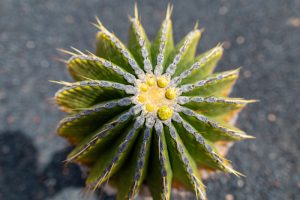Indoor Cactus Growing Ideas

In addition to the outdoors, many cacti can thrive in an indoor environment. Both desert and forest cacti can live long and healthy lives indoors. Check out these few tips for growing the plants.
Growing Indoor Desert Cacti Tips
Desert cacti are very easy growing plants and they can produce some beautiful blooms and flowers. These tips will come in handy for growing desert cacti, regardless of the type of cacti you have:
- A strong light source is needed for the cacti, especially during the cooler parts of the year. It is possible to scorch a cactus that receives too much light in the summer, though.
- Keep the cacti in an area of 70-80 degrees Fahrenheit during summer months, and around 55 degrees in the winter.
- Water the cacti whenever the compost starts to dry during the summer. Only add water if you notice the cacti shriveling in the winter months.
- You can pot the cacti in soil, with the addition of perlite that increase aeration and drainage. The cacti won’t often need any repotting.
- During growing season, using a specialized fertilizer can greatly benefit the cactus. Non-cacti fertilizers will not produce the same quality plant as a specialized fertilizer.
- Overwatering can be very damaging to your cactus. This can cause rot at the base of the plant or at the tip. If you discover rot, this may be the best time to establish a new plant by utilizing cuttings.
Growing Indoor Forest Cacti Tips
These plants, found in tropical and subtropical regions, make great hanging plants. Here are a few specific growing tips that will differ from desert cacti:
- Forest cacti need bright, yet non-direct sunlight.
- Forest cacti will thrive between 55-70 degrees Fahrenheit during their growing season. During the rest of the cycle, though, a cooler 50 degrees is desired.
- You can water the plant just like any other plant during the summers.
- Whenever the plant is resting, only water it when the soil is dry.
- Repot these plants at the start of each growing season with a regular potting mix.
- Standard fertilizers will work for forest cacti, but make sure to taper them down throughout the growing cycle.
- If you have a Christmas cactus, cut the plant back before planting it. Also keep the plant in an area of 50-55 degrees Fahrenheit.
- After 30-60 days, take the plant to a warmer area. Resume the normal watering process at this point.
- Move the cactus outside for the summer.
- During the rest cycle, forest cacti do not to be watered heavily.
Desert Plants For Sale
If you are interested in increasing the beauty of your landscape by buying desert plants, stop by our convenient location at 33840 N. Cave Creek Rd., in Cave Creek. For customers interested in our landscaping services, give us a call at (480) 488-9455 to schedule a visit to your home.
More Articles About Arizona Landscaping
- 10 Incredible Saguaro Cactus Facts
- Where To Buy Saguaro Cactus
- How To Save A Dying Cactus
- How To Bring A Dead Palm Tree Back To Life
- Landscaping Prices In Arizona
- Landscape Boulders Cost
- How To Take Care Of A Cactus In Arizona | Gardening Tips
- Desert Shrubs
- When are the Saguaro Cactus in Bloom in AZ?
- Mulch vs Compost | Differences
- Garden Soil Vs. Potting Mix | Differences
- What Type Of Water Fountain Should I Buy?
- What is Xeriscape?
- The Benefits of Ground Covering Plants
- Desert Plants
- Common Desert Plants Found in Arizona
- Garden Water Fountains
- Types of Cactus
- Different Types of Water Fountains for Your Garden
- Desert Landscaping Phoenix
- Sonoran Desert Landscape Rocks
- Arizona Xeriscape Gardening





